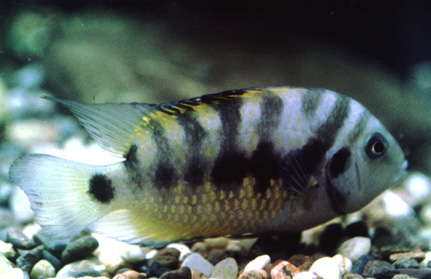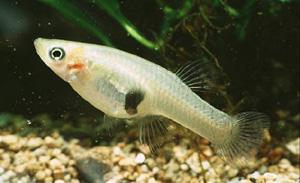|
Teaching
Research
Outreach
People
Publications
Home
Biology Home
|
Current Projects
|
Courtship and Mate
Choice in Fishes:
Integrating Behavioral and Visual Ecology |
|

|
A male Limia perugiae,
above left, courting a female, below right. |
This
project focuses on the interaction between male breeding
coloration as honest signals and female choice, within the
constraints of the visual
ecology of the species in question. Current projects focus on
two species of poeciliid fishes, Perugia's Limia (Limia
perugiae) and the guppy (Poecilia reticulata). Representative
Publications: Rush, VN, McKinnon, JS, Abney, MA &
Sargent, RC, 2003. Reflectance spectra from free-swimming
sticklebacks (Gasterosteus): Social context and eye-jaw
contrast. Behaviour, 140:1003-1019. (pdf)
Sargent, RC, Rush, VN,
Wisenden, BD & Yan, HY, 1998. Courtship and mate choice in fishes: integrating
behavioral and sensory ecology. American Zoologist, 38:82-96.
(pdf)
|
|
Condition
Indicators in the Limiting Sex |
|
A female convict cichlid, Archocentrus
nigrofasciatum. The orange coloration generally is not
expressed in males. |
 |
This
project focuses on the functional significance of female
breeding coloration in the convict cichlid, Archocentrus
nigrofasciatum. Preliminary data suggest that this
coloration may correlate with female fecundity, and possibly
energy reserves. Current experiments are examining how male and
female convict cichlids respond to female breeding coloration.
Future projects will examine female signaling in poeciliid
fishes. This project began as Kasi
Jackson's doctoral dissertation. Representative
Publications: Jackson,
JK, Brown, AL, Lloyd, TK, Orsborne, T, & Sargent, RC, In
preparation. Effects of diet on female breeding coloration in
the convict cichlid, Archocentrus nigrofasciatum. |
Interactions
Between
Intersexual & Intrasexual Conflict |
 |
A female western mosquitofish, Gambusia
affinis. |
This
project focuses on the interaction between male sexual harassment
of females, and female dominance hierarchies in the
mosquitofish, Gambusia affinis. Previous work found that
female density dependence can swamp the negative effects of male
harassment, such that females have higher fecundity and growth
at high male and low female density, despite experiencing higher
rates of male harassment under these conditions (Smith &
Sargent 2006). Preliminary data suggest that females have
size dependent dominance hierarchies, that males preferentially
harass larger females, and that male harassment can reverse the
size dependent effects of female dominance on growth in
subordinate females. This project began as Chad
Smith's masters thesis. Current experiments include using microsatellite
DNA markers to test hypotheses on potential genetic benefits
of multiple mating. Representative
Publications: Smith, CC & Sargent, RC, 2006. Female
fitness declines with increasing female density but not male
harassment in the western mosquitofish, Gambusia affinis.
Animal Behaviour 71:401-407. (pdf) Smith,
CC, 2007. Independent effects of male and female density on
sexual harassment, female fitness, and male competition for
mates in the western mosquitofish. Behavioral Ecology and
Sociobiology 61:1349-1358.(pdf) |
|
Egg Trading in
Simultaneous Hermphrodites |
|
Chalk bass, Serranus
tortugarum. |

|
| This project is the
doctoral dissertation research of Mary
Hart, who is co-advised by Phil
Crowley and Craig Sargent. This project examines how
"streaking" (i.e. stolen fertilizations from extra-pair
fish) effects the cooperation between partners who take turns
playing male and female roles, alternately releasing eggs and
sperm. This project also examines how ecological variables such as
predation risk and population density effect streaking and the
degree of cooperation within pairs.
Representative Publications:
Crowley, PH, T Cottrell, T Garcia, M Hatch,
RC Sargent, BJ Stokes, and JM White 1998. Solving the
complementarity dilemma: Evolving strategies for simultaneous
hermaphroditism. Journal of Theoretical Biology, 195:13-26.
(pdf)
Hart, MK, Kratter, AW, Svoboda, A-M,
Lawrence, CL, Sargent, RC and Crowley, PH. 2010. Sex allocation in
a group-living simultaneous hermaphrodite: effects of density at
two different spatial scales. Evolutionary
Ecology Research, 12:189-202 (pdf) |
|
Meditation, Sleep
& Performance |
|

|
Mediation in the O'Hara Lab
(left to right: Bruce O'Hara, Prashant Kaul, Ling Liu)
|
| This project is the
doctoral dissertation research of Prashant Kaul, who is co-advised by
Bruce
O'Hara and Craig Sargent. This project addresses the
interaction between sleep, meditation and performance. One
question is whether meditation can pay off sleep debt, as has been
claimed by some practitioners. Another question, is whether
meditation improves performance on tasks that are sensitive to
sleep debt, such as reaction time on a Psychomotor Vigilance Task
(PVT). Our data indicate that meditation provides at least a short
term enhancement on PVT performance in both rested and
sleep-deprived meditators, in both novice meditators trained at
the University of Kentucky and experienced meditators in India.
Data from experienced meditators in India also suggest that
meditation may be able to replace a portion of sleep time, but
cannot totally replace sleep.
Representative Publications:
Kaul, P, Passafiume, J, Sargent, C &
O'Hara, B. 2010. Meditation acutely improves psychomotor vigilance, and
may decrease sleep need. Behavioral and Brain
Functions 2010, 6:47 (29 July 2010) (pdf)
|
|